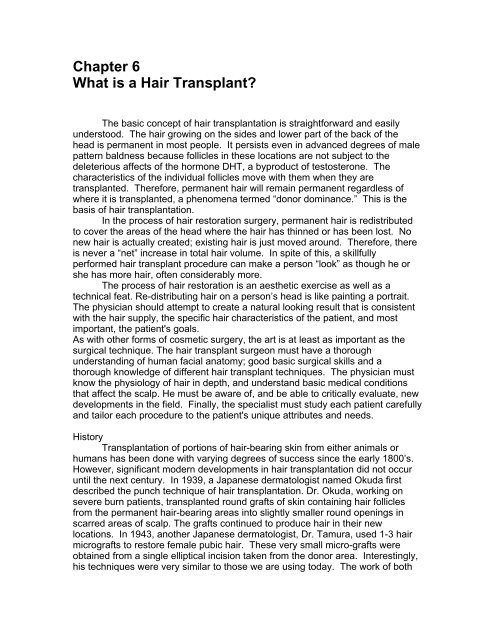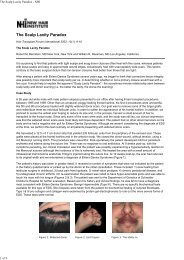The Patient's Guide to Hair Restoration - New Hair Institute
The Patient's Guide to Hair Restoration - New Hair Institute
The Patient's Guide to Hair Restoration - New Hair Institute
Create successful ePaper yourself
Turn your PDF publications into a flip-book with our unique Google optimized e-Paper software.
Chapter 6<br />
What is a <strong>Hair</strong> Transplant?<br />
<strong>The</strong> basic concept of hair transplantation is straightforward and easily<br />
unders<strong>to</strong>od. <strong>The</strong> hair growing on the sides and lower part of the back of the<br />
head is permanent in most people. It persists even in advanced degrees of male<br />
pattern baldness because follicles in these locations are not subject <strong>to</strong> the<br />
deleterious affects of the hormone DHT, a byproduct of tes<strong>to</strong>sterone. <strong>The</strong><br />
characteristics of the individual follicles move with them when they are<br />
transplanted. <strong>The</strong>refore, permanent hair will remain permanent regardless of<br />
where it is transplanted, a phenomena termed “donor dominance.” This is the<br />
basis of hair transplantation.<br />
In the process of hair res<strong>to</strong>ration surgery, permanent hair is redistributed<br />
<strong>to</strong> cover the areas of the head where the hair has thinned or has been lost. No<br />
new hair is actually created; existing hair is just moved around. <strong>The</strong>refore, there<br />
is never a “net” increase in <strong>to</strong>tal hair volume. In spite of this, a skillfully<br />
performed hair transplant procedure can make a person “look” as though he or<br />
she has more hair, often considerably more.<br />
<strong>The</strong> process of hair res<strong>to</strong>ration is an aesthetic exercise as well as a<br />
technical feat. Re-distributing hair on a person’s head is like painting a portrait.<br />
<strong>The</strong> physician should attempt <strong>to</strong> create a natural looking result that is consistent<br />
with the hair supply, the specific hair characteristics of the patient, and most<br />
important, the patient's goals.<br />
As with other forms of cosmetic surgery, the art is at least as important as the<br />
surgical technique. <strong>The</strong> hair transplant surgeon must have a thorough<br />
understanding of human facial ana<strong>to</strong>my; good basic surgical skills and a<br />
thorough knowledge of different hair transplant techniques. <strong>The</strong> physician must<br />
know the physiology of hair in depth, and understand basic medical conditions<br />
that affect the scalp. He must be aware of, and be able <strong>to</strong> critically evaluate, new<br />
developments in the field. Finally, the specialist must study each patient carefully<br />
and tailor each procedure <strong>to</strong> the patient's unique attributes and needs.<br />
His<strong>to</strong>ry<br />
Transplantation of portions of hair-bearing skin from either animals or<br />
humans has been done with varying degrees of success since the early 1800’s.<br />
However, significant modern developments in hair transplantation did not occur<br />
until the next century. In 1939, a Japanese derma<strong>to</strong>logist named Okuda first<br />
described the punch technique of hair transplantation. Dr. Okuda, working on<br />
severe burn patients, transplanted round grafts of skin containing hair follicles<br />
from the permanent hair-bearing areas in<strong>to</strong> slightly smaller round openings in<br />
scarred areas of scalp. <strong>The</strong> grafts continued <strong>to</strong> produce hair in their new<br />
locations. In 1943, another Japanese derma<strong>to</strong>logist, Dr. Tamura, used 1-3 hair<br />
micrografts <strong>to</strong> res<strong>to</strong>re female pubic hair. <strong>The</strong>se very small micro-grafts were<br />
obtained from a single elliptical incision taken from the donor area. Interestingly,<br />
his techniques were very similar <strong>to</strong> those we are using <strong>to</strong>day. <strong>The</strong> work of both



